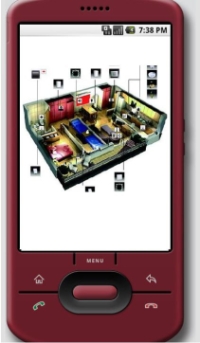Difference between revisions of "Increasing use of mobile phones as universal interface/controller"
Danielpeters (talk | contribs) |
Danielpeters (talk | contribs) |
||
| Line 27: | Line 27: | ||
==Inhibitors== | ==Inhibitors== | ||
* | * The need for manufacturers to collaborate: e.g. Nokia must collaborate with GE to agree on standards for data communication between phones and appliances. | ||
* | * People are reluctant to increase their dependence on one device (phone) which becomes a single point of failure | ||
==Paradigms== | ==Paradigms== | ||
Revision as of 14:42, 13 September 2009
The increasing use of mobile phones as universal interface/controller
This page is under construction by Daniel Peters EMBA09. In case of any questions/remarks or if you feel like sharing thoughts on the topic, by all means contact me.
Description
Mobile phones are increasing in capabilities (processing power, WiFi capability, GPS, on-phone applications, etc.) and have turned into ‘mini computers’. Today’s mobile phone has processing power on par with that of early webservers [1]. It is conceivable that in the future, all household appliances are controlled through one single device, the mobile phone.
For example, Google has introduced features on its Android phone that enable control of home appliances via the Domotica technology (see figure below): "Android Domotica Control allows the use to control many home appliances, lights, alarms, cameras, heating, and several other home subsystems from a remote location. This system can be integrated with current alarm monitoring systems to provide an instant view of your home even when you are not there. Android Domotica Control also connects to a network of sensors (e.g. motion) installed throughout the house which when triggered send video information to the Android terminal allowing the user to directly see the source of the alarm." [2]
Enablers
- Continuously Evolving Wireless Technologies
- Disruptive Technology: Wireless Local Loop
- Embedded Systems
- Increasing Human-Computer Interaction
- Mobility
- The increase of digital developing functions in a mobile phone
- The Future of TV
- The Increase in the speed of internet connection
- The Increasing Use of Internet
- Growth of third-party application developers, e.g. Apple 'appstore' with iPhone applications [3]
Inhibitors
- The need for manufacturers to collaborate: e.g. Nokia must collaborate with GE to agree on standards for data communication between phones and appliances.
- People are reluctant to increase their dependence on one device (phone) which becomes a single point of failure
Paradigms
At present, interaction with in-home appliances (TV, stove, microwave, fridge, ...), in-car appliances (navigation system, Audio/DVD player, airco, ...) and machines/equipment around us (ATM, supermarket scanner/checkout, train ticket machine, ...) is done through interfaces specific to those appliances: a TV has a remote, a microwave oven has a set of control buttons, a car has a control console, an ATM is controlled through the touchpad on the machine.
A phone-controlled appliance is one which doesn't have its own control panel, but is wirelessly connected to a user's mobile phone, which displays the control panel for the device. In a store a customer purchases a ‘phone-controlled fridge/microwave/TV/espresso machine/'. All these appliances can wirelessly ‘connect’ with one another and with the user's phone. The appliance comes with software which is loaded onto the phone and with which the appliance can be controlled, removing the need for and interface on the appliance itself. This will lower the price of the appliance.
Timing
2000:
2005:
2010: T-Mobile plans to launch mobile phone to control the home [4]
2015:
Web Resources
- http://research.nokia.com/research/projects/mobile-web-server
- http://android.marvinlee.net/tag/android-domotica-control
- http://business.rediff.com/report/2009/aug/17/tech-application-development-means-big-business.htm
- http://www.nytimes.com/2009/04/06/technology/companies/06android.html?_r=2
- http://en.wikipedia.org/wiki/Smartphone
- http://bluetooth-remote-control.smartcode.com/info.html
- http://knowledge.wharton.upenn.edu/article.cfm?articleid=1360
